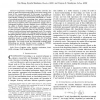357 search results - page 54 / 72 » Channel Diversity in Random Wireless Networks |
MOBIHOC
2008
ACM
14 years 8 months ago
2008
ACM
We study the multicast capacity of a random wireless network consisting of ordinary wireless nodes and base stations, known as a hybrid network. Assume that n ordinary wireless no...
TWC
2010
13 years 3 months ago
2010
Cooperative forwarding in wireless networks has shown to yield rate and diversity gains, but it incurs energy costs borne by the cooperating nodes. In this paper we consider an inc...
TCOM
2010
13 years 7 months ago
2010
In wireless multi-hop packet radio networks (MPRNs) that employ geographic transmissions, sleep schedules or node activation techniques may be used to power off some nodes to cons...
GLOBECOM
2009
IEEE
14 years 3 months ago
2009
IEEE
—A key technology in cooperative communications is distributed space-time coding (DSTC) which achieves spatial diversity gain from multiple relays. A novel DSTC, called randomize...
NOSSDAV
2011
Springer
12 years 11 months ago
2011
Springer
A primary challenge in multicasting video in a wireless LAN is to deal with the client diversity – clients may have different channel characteristics and hence receive different...

